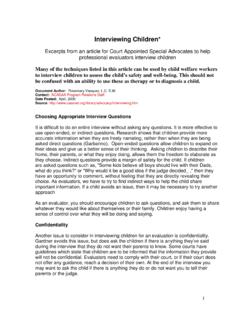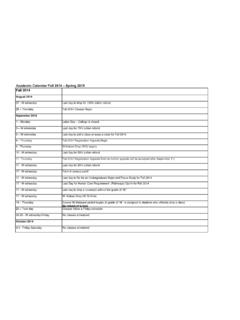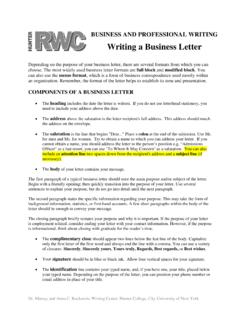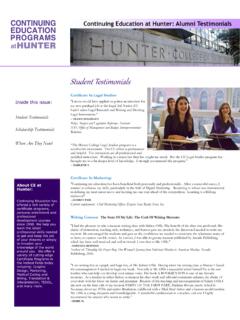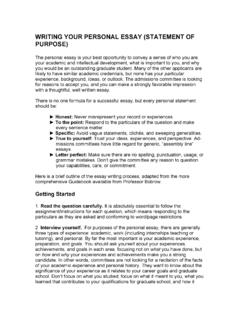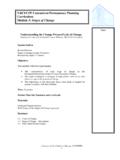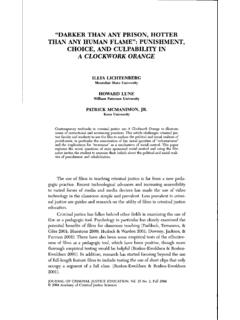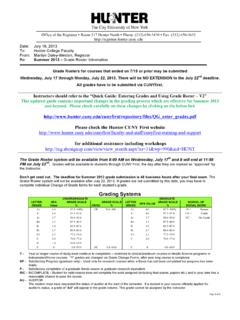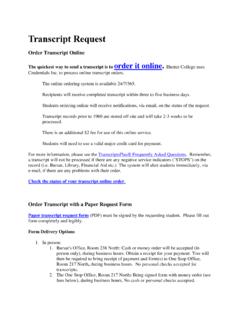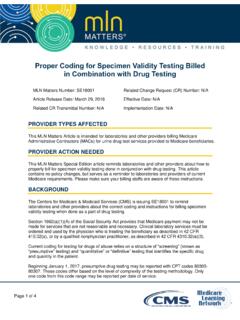Transcription of What is Plagiarism
1 Document provided by and Research Resources. Turnitin allows free distribution and non-profit use of this document in educational settings. What is Plagiarism Many people think of Plagiarism as copying another s work, or borrowing someone else s original ideas. But terms like copying and borrowing can disguise the seriousness of the offense: According to the Merriam-Webster OnLine Dictionary, to plagiarize means 1) to steal and pass off (the ideas or words of another) as one's own 2) to use (another's production) without crediting the source 3) to commit literary theft 4) to present as new and original an idea or product derived from an existing source. In other words, Plagiarism is an act of fraud. It involves both stealing someone else s work and lying about it afterward. But can words and ideas really be stolen? According to law, the answer is yes.
2 In the United States and many other countries, the expression of original ideas is considered intellectual property, and is protected by copyright laws, just like original inventions. Almost all forms of expression fall under copyright protection as long as they are recorded in some media (such as a book or a computer file). All of the following are considered Plagiarism : turning in someone else s work as your own copying words or ideas from someone else without giving credit failing to put a quotation in quotation marks giving incorrect information about the source of a quotation changing words but copying the sentence structure of a source without giving credit copying so many words or ideas from a source that it makes up the majority of your work, whether you give credit or not (see our section on fair use rules) Attention!
3 Changing the words of an original source is not sufficient to prevent Plagiarism . If you have retained the essential idea of an original source, and have not cited it, then no matter how drastically you may have altered its context or presentation, you have still plagiarized Document provided by and Research Resources. Turnitin allows free distribution and non-profit use of this document in educational settings. Most cases of Plagiarism can be avoided, however, by citing sources. Simply acknowledging that certain material has been borrowed, and providing your audience with the information necessary to find that source, is usually enough to prevent Plagiarism . Document provided by and Research Resources. Turnitin allows free distribution and non-profit use of this document in educational settings. Types of Plagiarism Anyone who has written or graded a paper knows that Plagiarism is not always a black-and-white issue.
4 The boundary between Plagiarism and research is often unclear. Learning to recognize the various forms of Plagiarism , especially the more ambiguous ones, is an important step in the fight to prevent it. I. SOURCES NOT CITED 1) The Ghost Writer The writer turns in another s work, word-for-word, as his or her own. 2) The Photocopy The writer copies significant portions of text straight from a single source, without alteration. 3) The Potluck Paper The writer tries to disguise Plagiarism by copying from several different sources, tweaking the sentences to make them fit together while retaining most of the original phrasing. 4) The Poor Disguise Although the writer has retained the essential content of the source, he or she has altered the paper s appearance slightly by changing key words and phrases. 5) The Labor of Laziness The writer takes the time to paraphrase most of the paper from other sources and make it all fit together, instead of spending the same effort on original work.
5 6) The Self-Stealer The writer borrows generously from his or her previous work, violating policies concerning the expectation of originality adopted by most academic institutions. II. SOURCES CITED (but still plagiarized!) Document provided by and Research Resources. Turnitin allows free distribution and non-profit use of this document in educational settings. 1) The Forgotten Footnote The writer mentions an author s name for a source, but neglects to include specific information on the location of the material referenced. This often masks other forms of Plagiarism by obscuring source locations. 2) The Misinformer The writer provides inaccurate information regarding the sources, making it impossible to find them. 3) The Too-Perfect Paraphrase The writer properly cites a source, but neglects to put in quotation marks text that has been copied word-for-word, or close to it.
6 Although attributing the basic ideas to the source, the writer is falsely claiming original presentation and interpretation of the information. 4) The Resourceful Citer The writer properly cites all sources, paraphrasing and using quotations appropriately. The catch? The paper contains almost no original work! It is sometimes difficult to spot this form of Plagiarism because it looks like any other well-researched document. 5) The Perfect Crime Well, we all know it doesn t exist. In this case, the writer properly quotes and cites sources in some places, but goes on to paraphrase other arguments from those sources without citation. This way, the writer tries to pass off the paraphrased material as his or her own analysis of the cited material . Document provided by and Research Resources. Turnitin allows free distribution and non-profit use of this document in educational settings.
7 FAQ What is Plagiarism ? Simply put, Plagiarism is the use of another's original words or ideas as though they were your own. Any time you borrow from an original source and do not give proper credit, you have committed Plagiarism and violated copyright laws. (See our What is Plagiarism ? page for more detailed information on Plagiarism .) What are copyright laws? Copyright laws exist to protect our intellectual property. They make it illegal to reproduce someone else s expression of ideas or information without permission. This can include music, images, written words, video, and a variety of other media. At one time, a work was only protected by copyright if it included a copyright trademark (the symbol). According to laws established in 1989, however, works are now copyright protected with or without the inclusion of this symbol. Anyone who reproduces copyrighted material improperly can be prosecuted in a court of law.
8 It does not matter if the form or content of the original has been altered as long as any material can be shown to be substantially similar to the original, it may be considered a violation of the Copyright Act. For information on how long a copyright lasts, see the section below on the public domain. Are all published works copyrighted ? Actually, no. The Copyright Act only protects works that express original ideas or information. For example, you could borrow liberally from the following without fear of Plagiarism : Compilations of readily available information, such as the phone book Works published by the government Facts that are not the result of original research (such as the fact that there are fifty states, or that carrots contain Vitamin A) Works in the public domain (provided you cite properly) Can facts be copyrighted ? Document provided by and Research Resources.
9 Turnitin allows free distribution and non-profit use of this document in educational settings. Yes, in some situations. Any facts that have been published as the result of individual research are considered the intellectual property of the author. Do I have to cite sources for every fact I use? No. You do not have to cite sources for facts that are not the result of unique individual research. Facts that are readily available from numerous sources and generally known to the public are considered common knowledge, and are not protected by copyright laws. You can use these facts liberally in your paper without citing authors. If you are unsure whether or not a fact is common knowledge, you should probably cite your source just to be safe. Does it matter how much was copied? Not in determining whether or not Plagiarism is a crime. If even the smallest part of a work is found to have been plagiarized, it is still considered a copyright violation, and its producer can be brought to trial.
10 However, the amount that was copied probably will have a bearing on the severity of the sentence. A work that is almost entirely plagiarized will almost certainly incur greater penalties than a work that only includes a small amount of plagiarized material . But can t I use material if I cite the source? You are allowed to borrow ideas or phrases from other sources provided you cite them properly and your usage is consistent with the guidelines set by fair use laws. As a rule, however, you should be careful about borrowing too liberally if the case can be made that your work consists predominantly of someone else s words or ideas, you may still be susceptible to charges of Plagiarism . What are the punishments for Plagiarism ? As with any wrongdoing, the degree of intent (see below) and the nature of the offense determine its status. When Plagiarism takes place in an academic setting, it is most often handled by the individual instructors and the academic institution involved.
